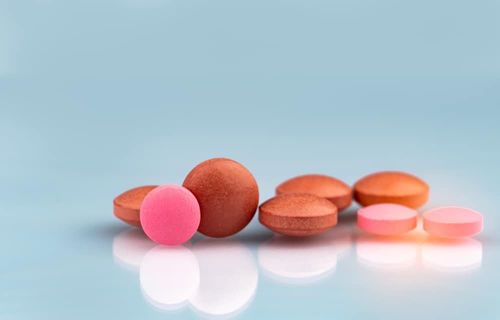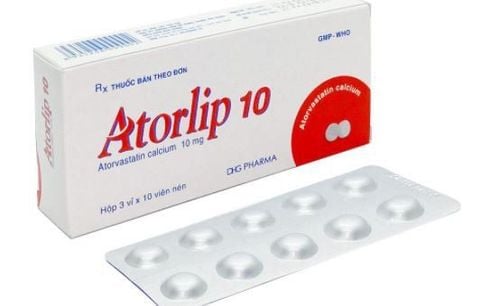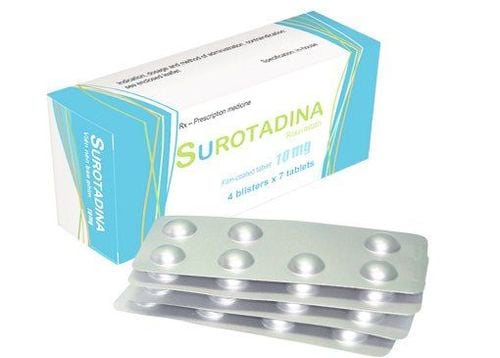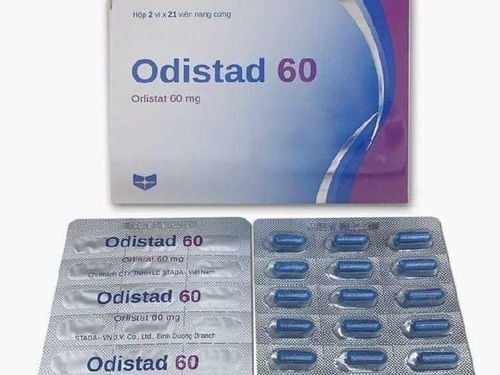This is an automatically translated article.
Atroact 20 is made in the form of tablets, the main ingredient is Atorvastatin calcium. The drug is used in the treatment of hypercholesterolemia.
1. What is Atroact 20mg?
Atroact 20mg medicine has the main ingredient is Atorvastatin calcium (equivalent to Atorvastatin 20mg). Atorvastatin calcium is a synthetic lipid-lowering agent that inhibits the reductase enzyme HMG-CoA. This enzyme catalyzes the conversion of HMG-CoA to mevalonate, the early and rate-limiting stage of cholesterol biosynthesis. In terms of mechanism of action, Atorvastatin is a competitive selective inhibitor of HMG-CoA reductase (a rate-limiting enzyme that converts HMG-CoA to mevalonate - a sterol precursor, including cholesterol). In patients with hypercholesterolemia, Atorvastatin reduces total cholesterol, LDL-C and apolipoprotein B. At the same time, it also reduces VLDL-C and triglycerides, increasing HDL-C.
Indications for use of Atroact 20:
Adjunctive therapy with diet for the purpose of reducing total cholesterol, triglycerides, LDL-cholesterol and apolipoprotein B in patients with primary hypercholesterolemia, due to heterogeneity zygotic or mixed hyperlipidemia; Adjunctive therapy with diet for patients with high serum triglycerides; Treatment of patients with primary dysbeta-lipoproteinemia who have not responded adequately to diet; Reduces the risk of myocardial infarction in hypertensive adults without clinical coronary artery disease but with at least 3 risk of coronary artery disease; Adjunctive therapy with diet to reduce total cholesterol, apolipoprotein B levels and low molecular weight cholesterol in children 10-17 years of age. Contraindications to the use of Atroact 20:
Patients with hypersensitivity to components of Atorvastatin; Patients with active liver disease, with persistent elevation of blood transaminases above 3 times the upper limit of normal (unknown cause); Pregnant women, breastfeeding mothers or people of childbearing potential who are not using birth control methods.
2. Usage and dosage of Atroact 20
Usage: Orally. Prior to treatment with Atorvastatin, high cholesterol should be controlled with appropriate diet, exercise, weight loss in obese patients, and treatment of the underlying medical condition. In addition, patients should continue to follow a cholesterol-lowering diet during treatment with Atorvastatin.
Dosage: Treatment should be started with the lowest effective dose of Atroact 20. Thereafter, if necessary, the dose can be adjusted according to the needs and response of the individual patient by increasing the dose at intervals not exceeding 4 weeks. In addition, when taking Atorvastatin with aminodarone, the dose should not exceed 20mg/day. At the same time, if combined with cyclosporin, the dose of Atorvastatin should not exceed 10 mg.
Starting dose: Recommended 10mg or 20mg x 1 time / day. For patients who need to reduce LDL-C much (over 45%) should start using 40mg / time / day. Dosage range from 10 - 80mg / time / day. The patient's dose is adjusted according to the LDL-C level, the goal of the treatment, and the patient's response. After initiation of therapy or dose adjustment of Atorvastatin, lipid levels should be tested within 2-4 weeks and dose adjusted accordingly;
Prevention of cardiovascular disease : Recommended dose 10mg/time/day;
Primary hypercholesterolemia and mixed hyperlipidemia: Most patients are controlled with 10mg/time/day. Usually clear treatment response within 2 weeks, maximum response within 4 weeks. This response is sustained with long-term treatment;
Homozygous hereditary hypercholesterolemia: Most patients respond to the 80mg dose (which results in an additional 15% reduction in low-molecular-weight cholesterol);
Pediatric patients 10 - 17 years old with heterozygous hereditary hypercholesterolemia: Start with 10mg/day, maximum dose is 20mg/day. Dosage is adjusted according to the purpose of treatment, the dose should be adjusted at intervals of more than 4 weeks;
Children: Treatment experience in children is limited to doses of Atorvastatin up to 80 mg/day for 1 year;
Elderly: There were no differences in safety and efficacy in patients compared with other subjects;
Patients with renal impairment : No dose adjustment is required;
Patients with liver failure: Contraindicated.
Overdose: There is no specific treatment for Atorvastatin overdose. In case of overdose, treatment should be symptomatic, and supportive measures should be taken if necessary.
3. Side effects of the drug Atroact 20
In general, Atorvastatin is well tolerated, so side effects are usually mild and transient. Only less than 2% of patients in clinical trials had to discontinue medication due to adverse events.
Some common side effects when using Atorvastatin are: Insomnia, headache, diarrhea, nausea, abdominal pain, constipation, gastrointestinal disturbances, bloating, muscle pain, weakness, impaired cognition. consciousness (confusion, memory loss,...), hyperglycemia, increased HbA1c,... Patients should inform their doctor about the side effects encountered when using Atroact 20 to receive advice. consult and make appropriate adjustments.
4. Be careful when using Atroact 20
Some notes for patients to remember before and while using Atroact 20:
Liver enzyme tests should be done before starting treatment with Atorvastatin and in case of clinical indications requiring testing; Prior to treatment, a creatinine kinase test should be performed if the patient has hypothyroidism, impaired renal function, personal or family history of hereditary myopathy, history of liver disease, heavy alcohol consumption, or history. myopathy due to previous statin or fibrate use. During treatment with Atorvastatin, the patient should notify the doctor if there are signs of muscle stiffness, weakness, muscle pain, ... When these symptoms are present, the patient should have a creatinine kinase test to have a blood test. appropriate interventions; Consider the use of Atorvastatin in patients with risk factors for muscle damage. The reason is that this drug can cause muscle atrophy, myositis, especially in people over 65 years old, kidney disease patients, patients with uncontrolled hypothyroidism. Attention should be paid to closely monitor adverse reactions during the course of drug use; HMG-CoA reductase inhibitors can cause biochemical abnormalities of liver function. Therefore, people with active liver disease or unexplained persistent elevations of transaminases should not use Atorvastatin; Patients taking Atorvastatin are at risk for rhabdomyolysis, acute renal failure secondary to myoglobinuria, and uncomplicated myalgia. Myalgia is muscle pain or weakness associated with increased creatinine phosphokinase values above 10 times the upper limit of normal. Atorvastatin therapy should be discontinued if a significant increase in creatinine phosphokinase is observed or myopathy is suspected; Do not use Atroact 20 in pregnant and lactating women.
5. Atroact 20 . drug interactions
Some drug interactions of Atroact 20 include:
Concomitant use of Atorvastatin with drugs that inhibit the CYP3A4 enzyme will increase plasma concentrations of Atorvastatin, leading to an increased risk of myopathy and myopathy. When atorvastatin is used in combination with amiodarone, the dose should not exceed 20 mg/day to avoid the risk of rhabdomyolysis. For patients who have to take doses above 20mg/day, the doctor may choose another statin drug such as pravastatin; The risk of myopathy during treatment with Atorvastatin is increased with concomitant use of cyclosporin, azole antifungals or niacin, fibric acid derivatives, erythromycin; Co-administration of Atorvastatin with antacid suspensions containing magnesium and aluminum reduces plasma concentrations of Atorvastatin by approximately 35%; When Atorvastatin was used with Colestipol, concentrations of Atorvastatin were reduced by approximately 25%. However, the simultaneous use of these two drugs increases the effect on lipids, instead of using each drug alone; When 10 mg of Atorvastatin and multiple doses of digoxin were administered concurrently, plasma digoxin concentrations remained steady. However, digoxin concentrations are increased by approximately 20% if digoxin is taken with 80 mg of Atorvastatin daily. Therefore, it is advisable to monitor the health of patients using digoxin; Concomitant use of Atorvastatin with erythromycin (500 mg/time x 4 times/day) or clarithromycin (500 mg/time x 2 times/day) increases plasma concentrations of Atorvastatin; Concomitant use of Atorvastatin with oral contraceptives containing norethindrone and ethinyl estradiol increases the concentration of norethindrone and ethinyl estradiol. This should be considered when combining drugs; Concomitant administration of Atorvastatin with protease inhibitors increases plasma concentrations of Atorvastatin; Increased risk of muscle damage if Atorvastatin is used concurrently with drugs: high doses of niacin (over 1g/day), Colchicin, Gemfibrozil, other fibrate-lowering cholesterol drugs; Concomitant use of Atorvastatin with drugs to treat HIV and hepatitis C may increase the risk of muscle damage, most seriously rhabdomyolysis, kidney failure leading to kidney failure, even death. When prescribed Atroact 20, patients should inform their doctor about the medications they are taking and their medical history. This will help the doctor have the appropriate consideration and adjustment, avoiding the risk of drug interactions or other adverse reactions.
Please dial HOTLINE for more information or register for an appointment HERE. Download MyVinmec app to make appointments faster and to manage your bookings easily.













